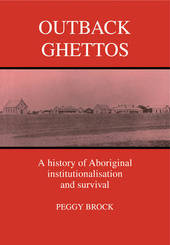
|
Outback Ghettos: Aborigines, Institutionalisation and Survival
Paperback / softback
Main Details
| Title |
Outback Ghettos: Aborigines, Institutionalisation and Survival
|
| Authors and Contributors |
By (author) Peggy Brock
|
| Series | Studies in Australian History |
|---|
| Physical Properties |
| Format:Paperback / softback | | Pages:192 | | Dimensions(mm): Height 244,Width 170 |
|
| ISBN/Barcode |
9780521447089
|
| Classifications | Dewey:306.0899915 |
|---|
| Audience | | Professional & Vocational | | General | | Tertiary Education (US: College) | |
|---|
| Illustrations |
Worked examples or Exercises
|
|
Publishing Details |
| Publisher |
Cambridge University Press
|
| Imprint |
Cambridge University Press
|
| Publication Date |
29 November 1993 |
| Publication Country |
United Kingdom
|
Description
Up until the 1970s, a large proportion of Aboriginal people in Australia had some experience in institutions as part of government assimilation and protection policies. By focusing on three communities in South Australia, this book attempts to understand the consequences of this institutionalisation for Aborigines and Australian society in general. Peggy Brock uses the word 'ghetto' to evoke the nature of the missions in which, for generations, many Aboriginal people settled, as ghettos both oppress and nurture those who live within them. Within the missions, Aborigines were able to establish strong communities and construct a modern identity. The three communities considered in the book - Poonindie, Koonibba and Nepabunna - existed during distinct but overlapping periods and had varying responses to colonialism and mission life. In many cases, Aboriginal people associated themselves with the missions because they met urgent needs for survival: protection from a hostile world, access to rations, education and training in European skills. In fact for many, the missions became home. For others however, the emotional turmoil caused by the pressure to embrace Christianity on the one hand and the desire to maintain traditional ways on the other became unbearable.
Reviews"This book is an impressive contribution to the burgeoning field in Aboriginal history that tries to track the formation and impact of missions and reserves on the Aboriginal peoples of Australia." American Historical Review
|